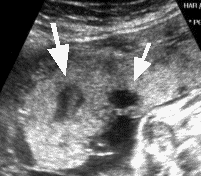Many of you reading may be wondering how Alisha and I ended up with a 1lb 3oz baby. As the saying goes, "hindsight is 20/20". Today I thought I'd explain some of what the doctors found out when they did Alisha's C-section back on October 6th. It'll also explain whether we should expect to hit problems (or as they say at work, "opportunities") like this in the future.
The first problem that Roscoe ran into was that his placenta, which supplies nutrients and blood flow. The placenta was undersized at about 25% of the size of a normal placenta. The placenta also had "lakes", which are pools of blood that show up in the middle of the placenta. They show up as big blank spots on an ultrasound like this:
The doctors are still determining whether this was caused by a genetic issue or just an unfortunate series of events. Yesterday Alisha submitted some blood samples that the doctors will send to a lab to determine whether she has a genetic trait that would cause an abnormally small or defective placenta. If she does, then that could mean we'd face a similar situation with any future kids. If the small placenta just happened (like any other defect), then this problem probably won't happen again.
The second problem Roscoe ran into was Alisha's uterus. Alisha's uterus has two abnormalities: it is heart-shaped ("bicornuate") and it has a separator ("septate").
Neither of these abnormalities will prevent us from having kids in the future, but they may lead to mild speedbumps. Specifically, one side of the heart shape is smaller than the other, so it will leave less room for the baby to grow (less than 1% of women have this). Since there's a separator which goes about 1/3 of the way through, it also closes the baby mostly into one half of the uterus (about 2% of women have this). After we learned this, Alisha realized why she always felt Roscoe on one side of her belly: he was stuck over there because of the separator! Luckily Roscoe was stuck on the larger side.
These abnormalities didn't cause the early delivery or growth restriction, but we were fortunate to learn that her uterus was built this way after they did the C-section. The only difficulty they might cause would be to make future pregnancies a little more cramped and less able to swim around freely (read more here). We do plan to have more kids (if God is willing) so we were thankful that God answered our prayers and gave the doctors the skill/opportunity to do a standard C-section, which allows for natural childbirth in future pregnancies.
If you are continuing to pray with us, please ask God that the lab results come back showing no signs that Alisha is genetically predisposed to a defective placenta.
PS: I hope to never write another blog post that uses the words "placenta" and "uterus" so frequently. As a man it just feels kind of awkward. I have to keep double-checking that I'm not accidentally using words like "polenta" instead.



Thanks Shaun for educating on a subject I'm sure you never imagined you would. Praying for you three! Much love, Colleen
ReplyDeleteShaun, I'm so proud of you. All I could think through the entire post was, "this is the man who won't sing 'lay your head on my breast' in church songs, and here he is educating all of us on the female reproductive system. Bahaha! So thankful little Roscoe is growing stronger, and praying for good news on the blood test results. God is so awesome!
ReplyDeleteYour PS made me laugh out loud.
ReplyDeleteLove you three!
Quote from Molly while she read this:
ReplyDelete"I bet this was so gross for him to do."
:o)
As long as I don't have to use the phrase "She is dilated X centimeters", I will be able to keep my lunch down.
DeleteDid you vomit after writing that?!?
ReplyDeleteoh my goodness!!! your PS was just what I needed after the work day. I laughed out loud. Thank you!
ReplyDelete